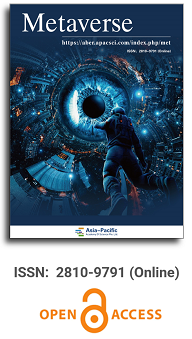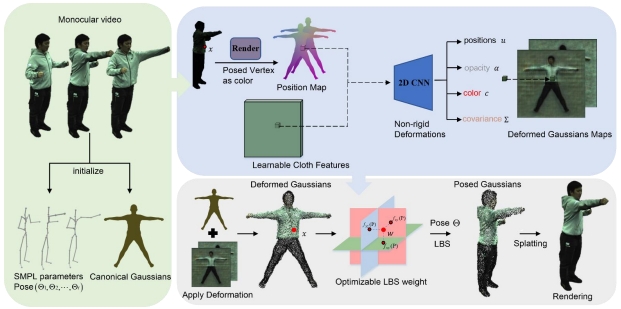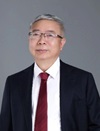
Asia Pacific Academy of Science Pte. Ltd. (APACSCI) specializes in international journal publishing. APACSCI adopts the open access publishing model and provides an important communication bridge for academic groups whose interest fields include engineering, technology, medicine, computer, mathematics, agriculture and forestry, and environment.



A qualitative study on the integration of artificial intelligence in cultural heritage conservation
Vol 5, Issue 2, 2024
Download PDF
Abstract
The widespread adoption of generative artificial intelligence (GAI) technologies heralds an era of expanding possibilities in the domain of cultural heritage conservation. This paradigm shift is marked by a confluence of innovative methodologies, including digital twin mapping, digital archiving, and enhanced preservation strategies, aimed at safeguarding the vestiges of our shared past. The application of AI within this field represents a frontier where technology and tradition intersect, offering new vistas for the preservation of historical structures and artifacts that are at risk of deterioration or oblivion. This article endeavors to elucidate the perspectives of professionals within the conservation domain on the integration of AI technologies, drawing upon a comprehensive review of scholarly discourse and the insights derived from a qualitative study. These discussions brought forth rich insights from a spectrum of professionals, each contributing unique perspectives based on their domain expertise and experiences. Participants included conservationists, archaeologists, museum curators, technologists, architects, and restorers, among others, whose collective wisdom paints a multifaceted picture of the challenges and opportunities AI presents in this field.
Keywords
References
- Yao Y, Wang X, Luo L, et al. An Overview of GIS-RS Applications for Archaeological and Cultural Heritage under the DBAR-Heritage Mission. Remote Sensing. 2023; 15(24): 5766. doi: 10.3390/rs15245766
- Jouan P, Hallot P. Digital Twin: Research Framework to Support Preventive Conservation Policies. ISPRS International Journal of Geo-Information. 2020; 9(4): 228. doi: 10.3390/ijgi9040228
- Dang X, Liu W, Hong Q, et al. Digital twin applications on cultural world heritage sites in China: A state-of-the-art overview. Journal of Cultural Heritage. 2023; 64: 228-243. doi: 10.1016/j.culher.2023.10.005
- Nishanbaev I. A web repository for geo-located 3D digital cultural heritage models. Digital Applications in Archaeology and Cultural Heritage. 2020; 16: e00139. doi: 10.1016/j.daach.2020.e00139
- Ponce J. An endless ladder: The preservation of digital interactive artworks. University of California, San Diego; 2022.
- Ikudayisi AE, Chan AP, Darko A, Adedeji YM. Integrated practices in the Architecture, Engineering, and Construction industry: Current scope and pathway towards Industry 5.0. Journal of Building Engineering. 2023; 73: 106788.
- Rane N. 3D, 4D, and 5D printing in Architecture, Engineering, and Construction (AEC) Industry: Applications, Challenges, and Future Scope. Engineering, and Construction (AEC) Industry: Applications, Challenges, and Future Scope (September 28, 2023). 2023.
- Ullah H, Manickam S, Obaidat M, et al. Exploring the Potential of Metaverse Technology in Healthcare: Applications, Challenges, and Future Directions. IEEE Access. 2023; 11: 69686-69707. doi: 10.1109/access.2023.3286696
- Zhou X, Chai C, Li G, et al. Database Meets Artificial Intelligence: A Survey. IEEE Transactions on Knowledge and Data Engineering. 2022; 34(3): 1096-1116. doi: 10.1109/tkde.2020.2994641
- Mansuri LE, Patel DA. Artificial intelligence-based automatic visual inspection system for built heritage. Smart and Sustainable Built Environment. 2021; 11(3): 622-646. doi: 10.1108/sasbe-09-2020-0139
- Shi W, Zhang M, Zhang R, et al. Change Detection Based on Artificial Intelligence: State-of-the-Art and Challenges. Remote Sensing. 2020; 12(10): 1688. doi: 10.3390/rs12101688
- Gaber JA, Youssef SM, Fathalla KM. The role of artificial intelligence and machine learning in preserving cultural heritage and art works via virtual restoration. ISPRS Annals of the Photogrammetry, Remote Sensing and Spatial Information Sciences. 2023; 185-190. doi: 10.5194/isprs-annals-x-1-w1-2023-185-2023
- Patel K. Ethical reflections on data-centric AI: balancing benefits and risks. International Journal of Artificial Intelligence Research and Development. 2024; 2(1): 1-17.
- Borg B, Dunn M, Ang A, et al. The application of state-of-the-art technologies to support artwork conservation: Literature review. Journal of Cultural Heritage. 2020; 44: 239-259. doi: 10.1016/j.culher.2020.02.010
- Opgenhaffen L. Archives in action. The impact of digital technology on archaeological recording strategies and ensuing open research archives. Digital Applications in Archaeology and Cultural Heritage. 2022; 27: e00231. doi: 10.1016/j.daach.2022.e00231
- Ozkaya I. What Is Really Different in Engineering AI-Enabled Systems? IEEE Software. 2020; 37(4): 3-6. doi: 10.1109/ms.2020.2993662
- Mishra M. Machine learning techniques for structural health monitoring of heritage buildings: A state-of-the-art review and case studies. Journal of Cultural Heritage. 2021; 47: 227-245. doi: 10.1016/j.culher.2020.09.005
- Hou S, Zhang S. Application of Artificial Intelligence-Based Sensor Technology in the Recommendation Model of Cultural Tourism Resources. Journal of Sensors. 2022; 2022: 1-8. doi: 10.1155/2022/3948298
- Pisoni G, Díaz-Rodríguez N, Gijlers H, et al. Human-Centered Artificial Intelligence for Designing Accessible Cultural Heritage. Applied Sciences. 2021; 11(2): 870. doi: 10.3390/app11020870
- Vidu C, Zbuchea A, Pinzaru F. Old meets new: integrating Artificial Intelligence in museums’ management practices. Strateg. Shap. Future Bus. Econ. 2021; 830-844.
- Wilkin N, Bevan A, Bonacchi C, et al. Crowd-sourcing the British Bronze Age: Initial experiences and results from the MicroPasts Project. Society of Museum Archaeologists; 35.
- Farella EM, Rigon S, Remondino F, et al. Methods, data and tools for facilitating a 3d cultural heritage space. The International Archives of the Photogrammetry, Remote Sensing and Spatial Information Sciences. 2024; 197-204. doi: 10.5194/isprs-archives-xlviii-2-w4-2024-197-2024
- Themistocleous K, Evagorou E, Mettas C, et al. The use of digital twin models to document cultural heritage monuments. In: Earth Resources and Environmental Remote Sensing/GIS Applications XIII. SPIE; 2022. pp. 55-64.
- Zhao J, Guo L, Li Y. Application of Digital Twin Combined with Artificial Intelligence and 5G Technology in the Art Design of Digital Museums. Wireless Communications and Mobile Computing. 2022; 2022: 1-12. doi: 10.1155/2022/8214514
- Ćosović M, Maksimović M. Application of the Digital Twin concept in cultural heritage. In: Proceedings of the VIPERC2022: 1st International virtual conference on visual pattern extraction and recognition for cultural heritage understanding.
- Xin L, Hongyu G, Kyeong SE, et al. Towards Cultural Heritage Digital Twin: Concept, Characteristics, Framework and Applications. In: Proceedings of the 2023 9th International Conference on Virtual Reality (ICVR). pp. 549-557.
- Hardman L, Aroyo L, van Ossenbruggen J, et al. Using AI to Access and Experience Cultural Heritage. IEEE Intelligent Systems. 2009; 24(2): 23-25. doi: 10.1109/mis.2009.37
- Carrino SFA, De Felice G, Fioretti P, et al. AI-Innovative digitization and management processes for Digital Libraries and Archives cultural heritage: Toward an inclusive and sustainable phygital ecosystem. In: Proceedings of the 2nd Italian Workshop on Artificial Intelligence for Cultural Heritage (IAI4CH 2023), co-located with the 22nd International Conference of the Italian Association for Artificial Intelligence (AIxIA 2023); 6-9 November 2023; Roma, Italy.
- Neudecker C. Cultural Heritage as Data: Digital Curation and Artificial Intelligence in Libraries. In: Proceedings of the Qurator 2022: 3rd Conference on Digital Curation Technologies; 9-23 September 2022; Berlin, Germany.
- Jaillant L, Caputo A. Unlocking digital archives: cross-disciplinary perspectives on AI and born-digital data. AI & Society. 2022; 37(3): 823-835. doi: 10.1007/s00146-021-01367-x
- Allam Z, Bibri SE, Sharpe SA. The Rising Impacts of the COVID-19 Pandemic and the Russia–Ukraine War: Energy Transition, Climate Justice, Global Inequality, and Supply Chain Disruption. Resources. 2022; 11(11): 99. doi: 10.3390/resources11110099
Supporting Agencies
Copyright (c) 2024 Kholoud Ghaith, James Hutson
License URL: https://creativecommons.org/licenses/by/4.0/

This site is licensed under a Creative Commons Attribution 4.0 International License (CC BY 4.0).

Prof. Zhigeng Pan
Director, Institute for Metaverse, Nanjing University of Information Science & Technology, China

Prof. Jianrong Tan
Academician, Chinese Academy of Engineering, China
Conference Time
December 15-18, 2025
Conference Venue
Hong Kong Convention and Exhibition Center (HKCEC)
...
Metaverse Scientist Forum No.3 was successfully held on April 22, 2025, from 19:00 to 20:30 (Beijing Time)...
We received the Scopus notification on April 19th, confirming that the journal has been successfully indexed by Scopus...
We are pleased to announce that we have updated the requirements for manuscript figures in the submission guidelines. Manuscripts submitted after April 15, 2025 are required to strictly adhere to the change. These updates are aimed at ensuring the highest quality of visual content in our publications and enhancing the overall readability and impact of your research. For more details, please find it in sumissions...






.jpg)
.jpg)

